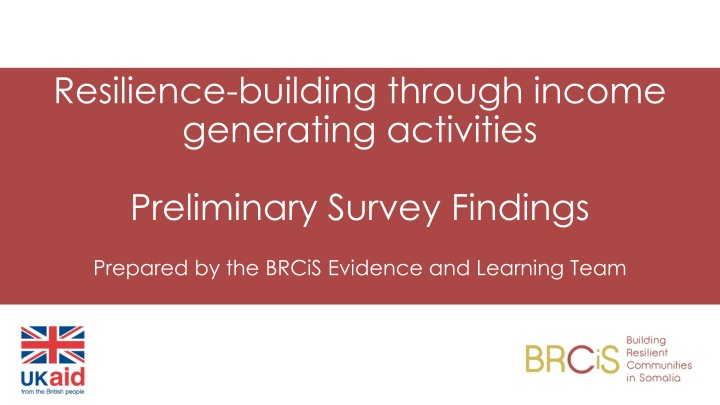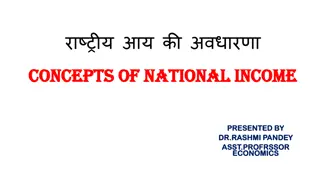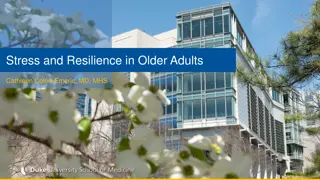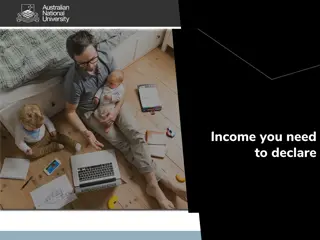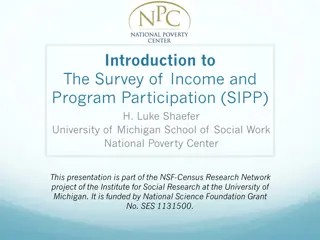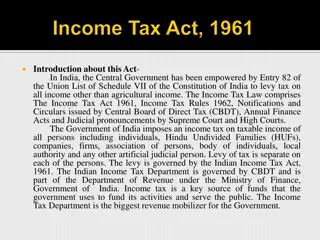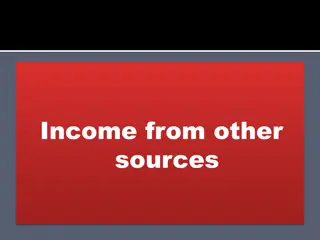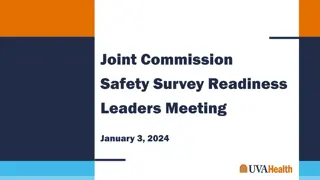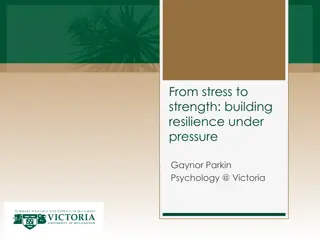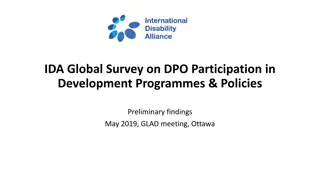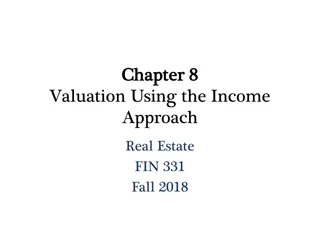Preliminary Survey Findings on Resilience-building through Income Generating Activities
Survey findings from the BRCiS Evidence and Learning Team show positive impacts of income generating activities in Somalia. The intervention led to increased private businesses, higher incomes, improved savings, and reduced debt among beneficiaries. The majority of businesses are still running post-intervention, with most citing lack of capital as a challenge. Beneficiaries have shown resilience in the face of shocks, with confidence in recovery and support networks. Data collection covered 335 respondents out of 338 targeted households supported through IGA interventions by BRCiS.
Download Presentation

Please find below an Image/Link to download the presentation.
The content on the website is provided AS IS for your information and personal use only. It may not be sold, licensed, or shared on other websites without obtaining consent from the author.If you encounter any issues during the download, it is possible that the publisher has removed the file from their server.
You are allowed to download the files provided on this website for personal or commercial use, subject to the condition that they are used lawfully. All files are the property of their respective owners.
The content on the website is provided AS IS for your information and personal use only. It may not be sold, licensed, or shared on other websites without obtaining consent from the author.
E N D
Presentation Transcript
Resilience-building through income generating activities Preliminary Survey Findings Prepared by the BRCiS Evidence and Learning Team
In this deck This slide deck contains top-level findings from a phone survey with ~333 income generating activities participants under the Building Resilient Communities in Somalia (BRCiS) Consortium. This analysis seeks to answer three main group of questions, alongside other aspects such as differences in the trainings administered and how this played out in the different livelihood groups. 1) Impact of the IGA interventions on the source and amount of income 2) Impact of the IGA interventions on savings and debt 3) Status and running of the businesses
Executive summary Beneficiaries who reported private business as a source of income increased by 15pp after the intervention while the fraction who relied on casual labour decreased by 9 pp. Beneficiaries who underwent individual business training recorded a higher transition to private business than those who were trained on business cooperatives. Income 70% of the beneficiaries reported that their income increased after the intervention. The monthly income increased from USD 60 to USD 100 after the intervention (median). 55% of the beneficiaries reported that their savings increased after the intervention. Savings and debt On average, each household currently has a savings of USD 20. 61% of the beneficiaries reported a decrease in debt (both in-cash and in-kind) after the intervention. Currently, households have a debt (both in-cash and in-kind) of USD 200.
Executive summary 92% of the businesses are still running. Beneficiaries who reported that their businesses were not running, cited lack of capital as the major reason. Business Approximately half of the beneficiaries who received a grant used it to partly start or continue a business and saved the rest. Over 72% of the beneficiaries keep inventory of goods and maintain income and expenditure records. On average, Afgooye, Belet-Hawa, Hudur and Wajid beneficiaries received four shocks. Shocks Failed or below average rain/drought was the most common shock experienced. 49% of the beneficiaries were able to meet their household needs. Household well-being 52% of the beneficiaries think they will be able to recover from shocks in the future. Over two thirds of the beneficiaries have confidence in their support networks to help them recover from future shocks
Data collection Overall, BRCiS supported 2,824 households through income generating activities (IGA) interventions between Q3-Q8. This survey covers a sample of 338 HHs. Data collection was conducted between 24th to 27th April 2021, reaching 335 respondents. 99% of the targeted beneficiaries were reached. Targets vs achieved Interviews conducted per training type received Training type Interviews Member Targeted Achieved % achieved Business cooperatives 143 AAH 128 126 98% CWW 80 79 99% Individual business training and grant 188 IRC 28 30 100% Vocational training 4 NRC 72 77 100% Total 335 SCI 30 23 77% Total 338 333 99% Source: BRCiS Income generating activities survey (April 2021) Source: BRCiS income generating activities survey (April 2021)
Demographics On average, the age of the respondents was 40 years 23% of the household heads had no education. Highest education level of household head Live zones Livezone Count (%) Highest education Count (%) Agro-pastoral 176 (53%) Quranic 198 (59%) Urban 107 (32%) No education 78 (23%) Pastoral 52 (16%) Some primary 34 (10%) Source: BRCiS Income generating activities survey (April 2021) Completed primary 15 (4%) Completed secondary 4 (1%) Not applicable 2 (1%) Some secondary 2 (1%) Don't know 1 (0%) Some university 1 (0%) Source: BRCiS income generating activities survey (April 2021) Source: BRCiS income generating activities survey (April 2021)
Sources of income A significant portion of participants managed to transit from casual labour to small businesses Beneficiaries who reported private business as a source of income increased by 15pp after the intervention while the fraction who relied on casual labour decreased by 9 pp. 4pp and 3pp decrease in the fraction of beneficiaries who practiced pastoralism and farming respectively after the intervention. Sources of income before and after the intervention Sources of income Before Currently Difference Private Business 106 (23%) 186 (38%) 15 pp Cash Transfers from Aid Agencies 24 (5%) 24 (5%) 0 pp Other 3 (1%) 4 (1%) 0 pp Remittances 7 (1%) 4 (1%) 0 pp Charcoal burning 1 (0%) 2 (0%) 0 pp Casual Labour 158 (34%) 123 (25%) -9 pp Livestock 62 (13%) 43 (9%) -4 pp Agriculture 110 (23%) 98 (20%) -3 pp Source: BRCiS Income generating activities survey (April 2021)
Sources of income Beneficiaries who underwent individual business training recorded a higher transition to private business than those who were trained on business cooperatives. Sources of income before and after the intervention per training done Training type Sources of income Before Currently Difference Business cooperatives Private Business 32 (15%) 54 (23%) 8 pp Cash Transfers from Aid Agencies 16 (7%) 22 (9%) 2 pp Casual Labour 65 (30%) Charcoal burning Other Remittances Agriculture Livestock 33 (15%) Formal Employment Private Business Other Agriculture Remittances Livestock 26 (11%) 70 (30%) 1 (0%) 1 (0%) 1 (0%) 61 (26%) 21 (9%) 1 (0%) 132 (54%) 3 (1%) 36 (15%) 3 (1%) 19 (8%) 0 pp 0 pp 0 pp -1 pp -6 pp -6 pp 1 (0%) 1 (0%) 2 (1%) 69 (32%) NA 74 (30%) 2 (1%) 40 (16%) 5 (2%) Individual business training and grant 24 pp 0 pp -1 pp -1 pp -3 pp Cash Transfers from Aid Agencies 8 (3%) 1 (0%) -3 pp Casual Labour 91 (37%) Charcoal burning 51 (21%) 1 (0%) -16 pp NA Source: BRCiS Income generating activities survey (April 2021)
Income 70% of the beneficiaries reported that their income increased after the intervention . Compared with one year ago how has your household income changed? Count (%) Significantly/ slightly increased 234 (70%) No change 59 (18%) Significantly/ slightly decreased 42 (12%) Source: BRCiS Income generating activities survey (April 2021)
Income Notably, female household members are increasingly contributing to household income. On average, in 2021 annual survey, 0.5 females contributed to household income while for the IGA beneficiaries, 0.9 contributed to household income. How many HH members are contributing to the HH income How many HH members are contributing to the HH income Male Female (median) Male Female (mean) Male (median) Female (median) Male (mean) Female (mean) Livezone Member (median) (mean) AAH 1 1 1.00 0.74 Agro-pastoral 1 1 0.88 0.87 CWW 1 1 0.86 1.08 IRC 0 1 0.33 0.93 Pastoral 0 1 0.41 0.85 NRC 1 1 0.58 0.95 Urban 1 1 0.6 0.95 SCI 0 1 0.61 1.04 Source: BRCiS Income generating activities survey (April 2021) Source: BRCiS Income generating activities survey (April 2021)
Income The monthly income increased from USD 60 to USD 100 after the intervention. The increase in monthly income was recorded by all member districts and livezones. Monthly income before and after the intervention (in USD) Monthly income before and after the intervention (in USD) Before (median) Currently (median) Difference (median) Before (mean) Currently (mean) Difference (mean) Before (median) Currently (median) Difference (median) Member N Livezone N AAH 68 100 32 126 Agro- pastoral 77 119 42 60 100 40 177 CWW 40 70 30 79 IRC 50 140 90 30 Pastoral 80 150 70 50 100 50 52 NRC 60 150 90 77 SCI 90 200 110 23 Urban 83 140 57 60 130 70 109 60 100 40 335 Source: BRCiS Income generating activities survey (April 2021) Source: BRCiS Income generating activities survey (April 2021)
Savings 55% of the beneficiaries reported that their savings increased after the intervention. On average, each household currently has a savings of USD 20 What is the total amount of cash savings of your household currently (in USD)? How has your savings changed after you have benefited from this intervention? Member Mean Median N Change Count (%) AAH 86 47 126 Significantly/Slightly increased 185 ( 55%) CWW 161 30 79 IRC 133 0 30 No change 122 ( 37%) NRC 23 0 77 Significantly/Slighltly decreased 26 ( 8%) SCI 172 70 23 Source: BRCiS Income generating activities survey (April 2021) 99 20 Source: BRCiS Income generating activities survey (April 2021)
Debt Significant decrease in debt (both in-kind and in-cash) after the intervention. 61% of the beneficiaries reported a decrease in debt (both in-cash and in-kind) after the intervention. Currently, households have a debt (both in-cash and in-kind) of USD 200. How has the amount of debt you have changed after you have benefited from this intervention? What is the total amount off in-kind and in-cash debt you have currently in USD? Member Mean Median N Count (%) AAH 242 150 126 Significantly/ Slightly decreased 204 (61%) CWW 259 150 79 IRC 582 500 30 No change 71 (21%) NRC 324 200 77 Significantly/ Slightly increased 58 (18%) SCI 255 250 23 294 200 335 Source: BRCiS Income generating activities survey (April 2021) Source: BRCiS Income generating activities survey (April 2021)
Business 92% of the businesses are still running. Beneficiaries who reported that their businesses were not running, cited lack of capital as the major reason. Why is the business not running? Is the business still running? Member Yes No Member NRC SCI CWW AAH CWW AAH AAH Count (%) 1 (100%) 2 (100%) 38 (90.5%) 89 (89.9%) 4 (9.5%) 5 (5.1%) 5 (5.1%) IRC 30 (100%) NA Lack of capital Lack of capital Lack of capital Lack of capital Separation of family Debt repayment Spent the returns on family expenses NRC 71 (95%) 4 (5%) SCI 21 (95%) 1 (5%) CWW 69 (93%) 5 (7%) AAH 59 (83%) 12 (17%) Total 250 (92%) 22 (8%) Source: BRCiS Income generating activities survey (April 2021) Source: BRCiS Income generating activities survey (April 2021)
Business There is a positive relationship between when the business was opened, current state of business and income change after the intervention. If business is still running per period the business was opened Income before and after per period the business was opened Income before Income currently Yes No N Difference N Before BRCiS (before 2018) 31 (96.9%) 1 (3.1%) 32 Before BRCiS (before 2018) 70 150 80 32 Beginning of BRCiS (2018 and 2019) 114 (93.4%) 8 (6.6%) 122 Beginning of BRCiS (2018 and 2019) 50 100 50 122 Latest IGA cohort (2020-2021) 107 (89.2%) 13 (10.8%) 120 Latest IGA cohort (2020-2021) 70 120 50 120 Source: BRCiS Income generating activities survey (April 2021) Source: BRCiS Income generating activities survey (April 2021)
Business Approximately half of the beneficiaries who received a grant used it to partly start or continue a business and saved the rest. On average, each beneficiary received USD 438. How much money (grant) did you receive to start or continue a business after the training? How did you use the grant given? I used it for something else (debt repayment, investment, education, health) Member Mean Median N Number of households that received a grant of less than USD 100 I used some part of it to star/continue a business and saved the rest I used the entire to start/continue a business activity Member AAH 203 120 30 11 AAH 13 (43%) 10 (33%) 7 (23%) CWW 309 150 65 14 CWW 20 (31%) 38 (58%) 7 (11%) IRC 687 700 30 0 IRC 2 (7%) 25 (83%) 3 (10%) NRC 492 500 77 0 NRC 24 (31%) 39 (51%) 14 (18%) SCI 500 500 23 0 SCI 16 (70%) 4 (17%) 3 (13%) 438 394 225 76 (36%) 116 (48%) 34 (15%) Source: BRCiS Income generating activities survey (April 2021) Source: BRCiS Income generating activities survey (April 2021)
Business Over 72% of the beneficiaries keep inventory of goods and maintain income and expenditure records. 72% of the beneficiaries keep inventory of their goods. 81% of the beneficiaries maintain records of their income and expenditure. Do you maintain records of your income and expenditure? Do you maintain records of your income and expenditure? Do you keep inventory of your goods? Respondent's gender Member Yes No Yes No Member Yes No IRC 27 (90%) 3 (10%) Male 33 (85%) 6 (15%) IRC 26 (87%) 4 (13%) AAH 48 (81%) 8 (14%) NRC 62 (87%) 8 (11%) Female 163 (77%) 45 (21%) SCI 14 (67%) 7 (33%) SCI 18 (86%) 3 (14%) NRC 46 (65%) 23 (32%) 196 (81%) 51 (18%) AAH 49 (83%) 9 (15%) CWW 42 (61%) 26 (38%) 176 (72%) 68 (26%) CWW 40 (58%) 28 (41%) Source: BRCiS Income generating activities Source: BRCiS Income generating activities survey (April 2021) survey (April 2021) 196 (81%) 51 (18%) Source: BRCiS Income generating activities survey (April 2021)
Shocks On average, Afgooye, Belet-Hawa, Hudur and Wajid beneficiaries received four shocks within the last year. Number of shocks District Adaado Afgooye Amadou Baidoa Bardere Beledweyn Belet-hawa Bondhere Borama/Quljed Burtinle Daynile Dhusamareb Elbarde Galdogob Galkacyo Hamarwayne Hodan Holwadag Hudur Kahda Karaan Kismayo Lascaanod Luuq Mataban Wadajir Wajid Wanlaweyn Yaqshiid Mean 1 4 0 1 2 2 4 1 3 2 2 1 3 2 2 0 3 2 4 1 2 1 0 1 3 3 4 2 2 Median 0 4 0 0 2 2 4 0 3 2 3 0 3 2 2 0 3 2 3 1 2 1 0 0 3 2 4 1 2 N 13 8 4 17 16 2 18 4 7 9 5 20 21 2 3 7 3 5 48 29 7 5 1 18 4 5 28 11 3 According to the EWEA dashboard, Afgooye, Belet- Hawa, Hudur and Wajid districts were re-flagged 10 -12 months within the last year Source: BRCiS Income generating activities survey (April 2021)
Shocks Failed or below average rain/drought was the most common shock experienced Five least commonly cited shocks Five most commonly cited shocks Shocks Count (%) Shocks Count (%) Unavailability of agricultural livestock/ fishery inputs 7 (1%) Failed or below average rain/drought 136 (18%) Fire including bush fire, electricity shocks explosions of gas cylinders etc. 2 (0%) Crop pests/locusts 99 (13%) Heavy storm 1 (0%) Increasing food prices 101 (13%) Violence against household members including injuries and death 3 (0%) Illness of household members 92 (12%) Weeds/ invasive species 1 (0%) Unemployment/ lack of jobs 75 (10%) Source: BRCiS Income generating activities survey (April 2021) Source: BRCiS Income generating activities survey (April 2021)
Shocks and state of business There was no clear difference in the number and type of shocks experienced by beneficiaries whose business were running and those whose business were not running. Type of shocks Number of shocks Is the business still running? (No) Is the business still running? (Yes) Shocks Number of shocks Is the business still running? (Yes) Is the business still running? (No) 0 530 (37.7%) 3 (9.7%) Failed or below average rain drought 44 (20%) 671 (17%) 1 248 (17.6%) 11 (35.5%) Crop pests locusts Unemployment lack of jobs Increasing food prices 19 (9%) 33 (15%) 15 (7%) 520 (13%) 332 (8%) 593 (15%) 2 171 (12.2%) 3 164 (11.7%) 3 (9.7%) 4 142 (10.1%) 5 (16.1%) Illness of household members Depletion of pasture Crop disease Malnutrition hunger Human disease outbreak for example cholera measles malaria or any other type 11 (5%) 25 (12%) 23 (11%) 16 (7%) 548 (14%) 161 (4%) 281 (7%) 150 (4%) 5 49 (3.5%) 6 52 (3.7%) 4 (12.9%) 7 32 (2.3%) 8 13 (0.9%) 5 (16.1%) 5 (2%) 183 (5%) 10 5 (0.4%) Source: BRCiS Income generating activities survey (April 2021) Excessive rains flooding Livestock disease /death Separation divorce of/ spouses Unavailability of agricultural livestock fishery inputs 9 (4%) 53 (1%) 8 (4%) 65 (2%) 4 (2%) 44 (1%) 5 (2%) 19 (0%) Source: BRCiS Income generating activities survey (April 2021)
Household well-being Half of the beneficiaries were able to meet their needs and they think they will be able to recover from shocks in future 49% of the beneficiaries were able to meet their household needs. 52% of the beneficiaries will be able to recover from shocks in the future. In the past month, how would you rate your family s overall wellbeing? How well do you consider that your household will be able to recover from shocks in the future? Midline Midline IGA IGA We are doing quite/really well and can meet most/all of our needs 36.96% 49% Will be able to recover to same level/ be better than before 29.5% 52% Will be able to recover somewhat, but will be worse off than before 36.26% 23% We are struggling quite a bit/a lot, and I am worried/don t think we will meet our needs in future 55.18% 39% Will not be able to recover at all 21.72% 9% We currently cannot meet our basic needs for survival 7.44% 11% Do not know 8.36% 16% Source: BRCiS Income generating activities survey (April 2021) Source: BRCiS Income generating activities survey (April 2021)
Household well-being Over two thirds of the beneficiaries have confidence in their support networks to help them recover from future shocks. How confident are you that you support networks could help you to recover? Member Count (%) 89 (71%) Quite/ Fairly/Very confident How confident are you that you support networks could help you to recover? Not very confident 36 (29%) AAH Not at all confident 1 (1%) Count Not at all confident 2 (67%) CESVI Quite/ Fairly/Very confident 242 (72%) Quite/ Fairly/Very confident 1 (33%) Not very confident 54 (16%) Quite/ Fairly/Very confident 58 (73%) Not at all confident 42 (12%) CWW Not at all confident 15 (19%) Source: BRCiS Income generating activities survey (April 2021) Not very confident Quite/ Fairly/Very confident 6 (8%) 23 (77%) Not very confident 5 (17%) IRC Not at all confident 2 (7%) Quite/ Fairly/Very confident 50 (65%) NRC Not at all confident 22 (29%) Not very confident Quite/ Fairly/Very confident 5 (6%) 21 (91%) SCI Not very confident 2 (9%) Source: BRCiS Income generating activities survey (April 2021)
